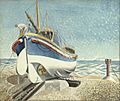RNLB Abdy Beauclerk (ON 751) facts for kids
class="infobox " style="float: right; clear: right; width: 315px; border-spacing: 2px; text-align: left; font-size: 90%;"
| colspan="2" style="text-align: center; font-size: 90%; line-height: 1.5em;" | 
|- | Official Number: || ON 751 |- | Donor: || |- | Station || No: 1 Station Aldeburgh |-
|} The RNLB Abdy Beauclerk (ON 751) was a special type of lifeboat called a 'Beach Motor' boat. She served at the Aldeburgh Lifeboat Station in Suffolk, England. This brave boat was on duty from 1931 until 1959, helping people at sea for 28 years.
Contents
| History | |
|---|---|
| Owner | Royal National Lifeboat Institution (RNLI) |
| Builder | J. Samuel White, Cowes, Isle of Wight |
| Laid down | 1931 |
| Acquired | 1931 |
| Fate |
|
| General characteristics | |
| Class and type | Watson beach class |
| Tonnage | Displacement of 16 tons |
| Length | 41 ft 0 in (12.50 m) overall |
| Beam | 12 ft 3 in (3.73 m) |
| Installed power | 2 x 35hp AEC Weyburn petrol |
| Propulsion | Twin screw set in tunnels |
| Speed | 7.5 kn (13.9 km/h) |
| Range | 122 nmi (226 km) |
| Notes | Also fitted with a mizzen mast and sail. |
What Made the Abdy Beauclerk Special?
The Abdy Beauclerk was the very first of five 'Aldeburgh' type motor beach lifeboats ever built. She was made in 1931 by J. Samuel White in Cowes, on the Isle of Wight.
Why a Beach Lifeboat?
Some lifeboat stations, like Aldeburgh, had flat beaches instead of deep harbors or slipways. This meant they needed a different kind of lifeboat. The Abdy Beauclerk was designed to be launched and recovered directly from the beach.
She was 41 feet (about 12.5 meters) long and 12 feet 3 inches (about 3.7 meters) wide. Even though she weighed almost 16 tons, her wide shape helped her float well in shallow water.
How She Moved and Was Powered
The lifeboat had two propellers, which are like underwater fans that push the boat. These propellers were tucked away in special tunnels. This protected them when the boat was launched or pulled back onto the beach.
The Abdy Beauclerk was powered by two 35-horsepower petrol engines. These engines gave her a top speed of 7.5 knots (about 14 kilometers per hour). She could travel about 122 miles (196 kilometers) on a single tank of fuel.
Even though most new lifeboats didn't use sails anymore, the crew at Aldeburgh asked for a small mizzen mast and sail. They liked having this extra way to help steer the boat.
Who Paid for Her?
The Abdy Beauclerk was paid for by a generous gift from the will of William Abdy Beauclerk. He was a wealthy man from Ascot, England.
Abdy Beauclerk's Time in Service
The Abdy Beauclerk arrived in Aldeburgh in December 1931. She was officially launched in May 1932 by Prince Albert, Duke of York, who later became King George VI.
A Brave Rescue in 1938
On November 23, 1938, the lifeboat was called out to help three barges in a strong storm. The barges were about two and a half miles from the station.
The first barge, Grecian, at first said they didn't need help. The second, Astriid, had lost its top sail and was damaged. The lifeboat took two crew members from the Astriid to safety. The third barge also refused help.
The Abdy Beauclerk went back to the Grecian and this time took two more crew members to safety. For his bravery during this rescue, the lifeboat's coxswain (the person in charge), George Chatten, received an RNLI Bronze Medal.
The Artist's Painting
In 1938, a famous artist named Eric Ravilious painted the Abdy Beauclerk. This painting is now kept at the Towner Gallery in Eastbourne.
Helping During World War II
During the Second World War, lifeboats along the coast of East Anglia helped with many rescues. The Abdy Beauclerk was the first English lifeboat to make a wartime rescue. This happened on September 10, 1939, just seven days after the war began.
The large merchant ship SS Magdapur was sinking after hitting a mine or being torpedoed. The Abdy Beauclerk helped rescue seventy people from the ship. They also found one of the six crew members who had sadly died.
Later, on May 30, 1940, the Abdy Beauclerk and another Aldeburgh lifeboat, the Lucy Lavers, were called by the Royal Navy. They went to help with the Dunkirk evacuation, a huge rescue mission, and stayed there until June 4, 1940.
Life After the RNLI
The Abdy Beauclerk stayed at the Aldeburgh station until 1959. She was then replaced by a newer lifeboat. The Abdy Beauclerk was sold by the RNLI and left their service.
She was renamed Saint Íte and worked as a pilot vessel for the Cork Harbour Commissioners in Ireland. A pilot vessel helps guide larger ships safely into and out of harbors. It is believed that she is still in Ireland today.
Images for kids


